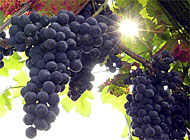Swiss growers offer “wines with character”

To compete with lower-cost imports, many Swiss wine growers are producing smaller quantities of quality wines.
In the vineyard of Eric Klausener in the Ticino village of Purasco above Lake Lugano, there is no sign of the gloom that affects many of Switzerland’s wine farmers. A dozen or so grape pickers, all friends of Klausener’s, are scattered across the vineyard, cheerfully picking dark blue Merlot grapes.
Most have taken a holiday from their jobs to be part of Klausener’s three-hectare family estate during the brief harvesting season in early October. They are proud to help in the production of a wine of superior quality that has won prizes and high praise from critics — Klausener’s Gran Riserva di Trevano.
Experts say that it is on estates like Klausener’s that Switzerland’s future as a winemaking region lies. Klausener, who moved to Ticino from western Switzerland in 1983 before building his reputation, agrees: “More and more people have developed a taste for wines with character, and are prepared to spend more money on the indulgence.”
But Klausener is a pioneer. In the whole of Ticino, Switzerland’s southern-most region where the common language is Italian, only 20 per cent of the wines can carry excellence labels. In other wine growing areas such as the Léman region between Geneva and Lausanne, the proportion is even smaller.
Drinking imported wine
It is in those regions that wine farmers feel the brunt of a crisis that was triggered by the government’s gradual liberalisation of wine imports. Since 1995, when the tariffs on foreign wines were reduced for the first time, the share of imports on the Swiss market for table wine soared from 12 to 25 per cent.
The consumption of indigenous wines, meanwhile, has decreased. In the six months to July of this year alone, Swiss wine makers lost 4.7 per cent of their domestic market share.
With wet weather prevailing throughout Switzerland in the two crucial months of June and September, this year’s harvest will yield big quantities of wine again. But the 2001 vintage will probably also be of a more inferior quality than in the average year, at least in the cheaper segments aimed at the mass market.
As a result, the record 70 million litres of Swiss wine stored away and not sold by July 2001 – the equivalent of 13 months of domestic consumption – may increase even further, market analysts predict.
Tractor blockade
Some wine farmers blame the government’s liberalisation programme for the glut. Last month, farmers from the Léman region protested the policy by blocking the square outside the federal parliament for three days with their tractors.
But Economics Minister Pascal Couchepin told them that the cabinet didn’t want to, nor could it, re-introduce protective measures, given international commitments in the framework of the World Trade Organisation (WTO). Farmers should produce less, but better wines instead, Couchepin recommended.
Guy Liand, a producer of quality wines in Savièse in canton Valais, agrees. He recalls the crisis and eventual bankruptcy in 1998 of Orsat, the region’s biggest wine producing co-operative. “Maybe we caught on earlier because we had the crisis in the early nineties that our colleagues in Vaud and Geneva have now.”
Liand, 43, who took over the eight hectares of vineyards his family have owned for generations, says about a third of his production now goes into quality wines that fetch between SFr20 ($12) and SFr60 a bottle. Winemakers everywhere in Valais have improved the value of their production by growing special varieties and using better winemaking methods. They also shifted production towards red wine, which had traditionally been eschewed in the region.
Advantages of Païen
One of Liand’s specialities is Païen (or Heida), a rare white variety with a thick skin that thrives in altitudes of up to 1,000 metres. It yields only around 0.5kg of grapes per square metre, just half the amount of mass production Fendant vines.
Païen grapes are ideal for a late November vintage. “Their high acidity gives the winemaker a lot of scope to play on”, Liand enthuses. As a further proof of the worthy character of the variety, Païen may only be bottled three years into storage, and achieves its best value not before another seven years later.
Labour intensive treatments like the re-introduction of sediment into young wine after an initial fermentation period also add to the cost of Païen and other specialities. This and the cost of changing the variety of a vineyard in the first place, which can come to SFr150, 000 ($90,000) per hectare, explains why many wine growers shy away from improving their product, Liand says.
But both Liand and Klausener are convinced to have made the right decision. “It is easily forgotten that in the [French] Bordeaux region, too, only about 20 per cent of wines are in the top market segment”, says Klausener.
“But thanks to their fame, the rest of Bordeaux wines also fetch reasonable prices. If with our wines we succeed in putting Ticino wines on the map internationally, we will have helped everyone”, Klausener says.
by Markus Haefliger

In compliance with the JTI standards
More: SWI swissinfo.ch certified by the Journalism Trust Initiative
You can find an overview of ongoing debates with our journalists here . Please join us!
If you want to start a conversation about a topic raised in this article or want to report factual errors, email us at english@swissinfo.ch.